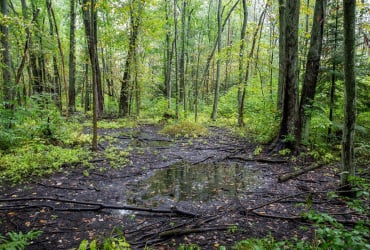Artificial fertilizers that are widely used in fields in Canada and around the world are responsible for nearly a third more greenhouse gas emissions than the global aviation industry, according to new research.
The study, which was not peer-reviewed, provides the first global estimate of the climate impacts of artificial fertilizers from manufacture to application in fields and orchards. It found that the production and use of chemicals are responsible for about one in 40 tons of greenhouse gases emitted annually worldwide. Canada is one of the top greenhouse gas emitters from fertilizers in the world.
Despite these damaging impacts, environmental and agricultural organizations that supported the research caution that countries are not doing enough to address the problem.
“Synthetic nitrogen fertilizers are a major driver of the climate crisis … and this research confirms that it is on the way to getting a lot worse,” explained Shane Moffatt, Greenpeace Canada’s director of food and nature campaigns (Greenpeace was one of the organizations behind the report). “Unless we take action now, (its use) will continue to grow.”
Synthetic fertilizers were relatively rare until the 1960s, when multilateral development banks, governments, philanthropists, and agricultural companies made a collective effort to create the so-called “green revolution” in agriculture. This approach produces large quantities of a few staple crops that produce high yields, if fed with artificial fertilizers and protected from disease with pesticides.
While supporters of the approach say it is an essential tool for feeding a rapidly growing population, critics note that it has done little to address the social and economic inequalities that drive hunger around the world. According to the Food and Agriculture Organization of the United Nations (FAO), around a third of the world’s food is produced on small, typically family-run farms that rely mainly on natural fertilizers and agricultural techniques.
What people are reading

Still, fertilizer-heavy industrial agriculture has exploded since the 1960s, particularly in countries that are economically dependent on food exports, such as the United States, Brazil, and Canada. However, the change had a significant environmental cost as excess fertilizers leached into waterways, causing algal blooms and ocean dead zones and the atmosphere. Only about a third of synthetic fertilizers applied to fields are turned into food, the report notes.
The creation of the chemicals, which are made from natural gas, also generates significant amounts of methane and carbon dioxide. An investigation of National Observer of Canada on the country’s largest emitters found that two fertilizer plants, one in Manitoba and one in Ontario, were responsible for roughly 1.4 million tonnes of CO2 equivalent in 2019, roughly equal to the annual emissions of 304,000 cars.
Fertilizer producers have argued for decades that these emissions can be reduced through more precise application of their products using robots and other technologies. However, the Greenpeace report notes that these promises have not been very successful.
For example, the study notes that Canadian farmers participating in the industry’s “4R Nutrient Stewardship Program,” an industry-led effort to reduce overuse of fertilizers, have increased their use of fertilizers. In addition, the country’s emissions from nitrogen fertilizers have increased in recent years, despite the program.
Late last year, the federal government announced plans to cut fertilizer emissions 30 percent below 2020 levels by 2030, a move that met with strong opposition from the fertilizer industry, Moffatt noted.
Artificial fertilizers that are widely used in fields in Canada and around the world are responsible for nearly a third more greenhouse gas emissions than the global aviation industry, according to new research. #GHGs
According to a May briefing obtained by Greenpeace through a freedom of information request, Fertilizer Canada, the lobby group representing Canadian fertilizer producers, met with Federal Agriculture Minister Marie-Claude Bibeau to reject the regulations. At the meeting, the industry sought federal endorsement of the 4R program, despite its flaws. Minister Bibeau did not commit to this approach, the document notes.
“In fact, we are seeing our elected officials and politicians trying to act in the public interest in the face of business pressure,” Moffatt said.
The fight is far from over. Last month, Fertilizer Canada released a report it commissioned that found that Canada’s 2030 goal of reducing fertilizer emissions could cost farmers $ 48 billion over the next decade. Most of these losses would stem from lower yields, he said. Fertilizer Canada did not respond to multiple requests for comment.
While Moffatt applauded Canada’s effort, he cautioned that similar measures aimed at phasing out nitrogen fertilizers globally are needed to address climate and pollution crises. So far, those efforts have been few, including at this year’s COP26 international climate conference.
The conference, also known as COP, short for Conference of the Parties, brings the world together to conclude agreements to reduce global warming. It has taken place since 1995. The talks bring together politicians, scientists, environmental activists, climate experts and the media from the 197 member countries of the United Nations Framework Convention on Climate Change. COP26 will take place in Glasgow, Scotland, from October 31 to November 12.
Moffatt said he hopes countries will focus on policies to support and develop more sustainable agricultural practices, such as agroecology or regenerative agriculture, that do not rely on synthetic fertilizers.
“These agrochemicals are controlled by a handful of global companies that wield enormous political influence and say they are essential to feeding people,” Moffatt said. “But there are a lot of leaders in the agricultural movement who are (using) practices that keep us away from these synthetic inputs. Really practical things, like cover crops or crop rotations, for example.”
Reference-www.nationalobserver.com